If you’re a cycling enthusiast or someone looking to get into road biking, you’ll quickly learn that the groupset is a critical component of your bike. Essentially, a groupset refers to all the mechanical components on your bike that control how you shift gears and brakes.
Choosing the right road bike groupset can make a huge difference in your cycling experience. It can impact how smoothly you shift, how quickly you can accelerate, and how efficiently you can climb hills.
There are many different options on the market, each with its unique features and benefits. To make an informed decision, it is crucial to have a comprehensive understanding of road bike groupsets. This article aims to provide you with an in-depth guide on the subject.
So, keep reading to choose the finest groupset for your needs.
What is a Road Bike Groupset
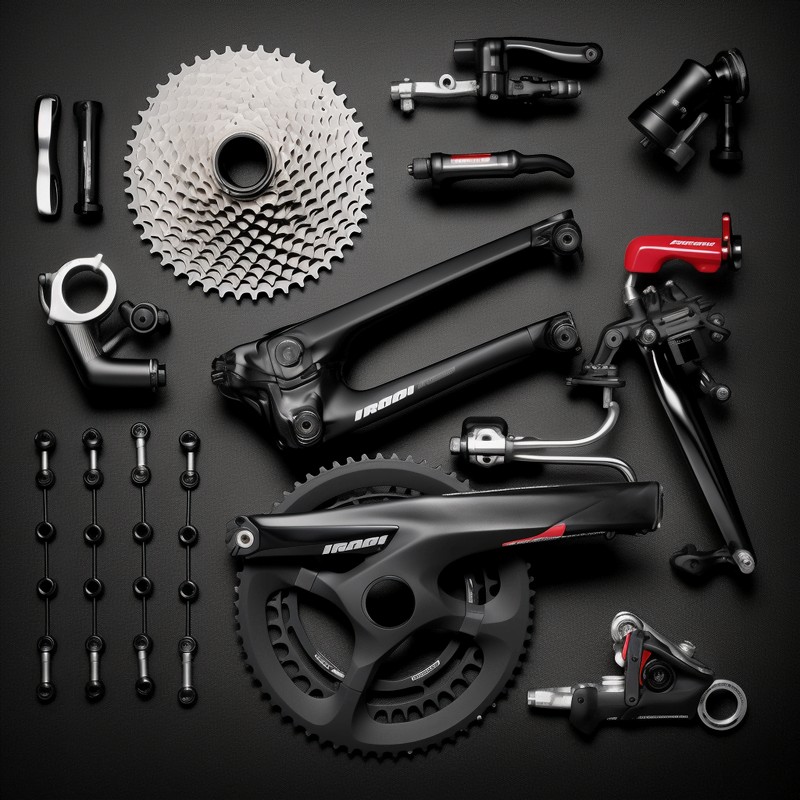
A road bike groupset refers to the collection of components that make up the drivetrain and braking system of a road bike. This includes the shifters, front and rear derailleurs, cassette, chain, brakes, and crankset.
A groupset typically includes components from the same manufacturer and is designed to work together seamlessly for optimal performance. The components are also typically designed to be compatible with each other in terms of gear ratios and number of speeds.
Higher-end groupsets usually offer more gears, lighter weight components, and better-shifting performance. Some well-known manufacturers of road bike groupsets include Shimano, SRAM, and Campagnolo.
Road Bike Groupset Components Detailed Explanation
1. Bottom Brackets
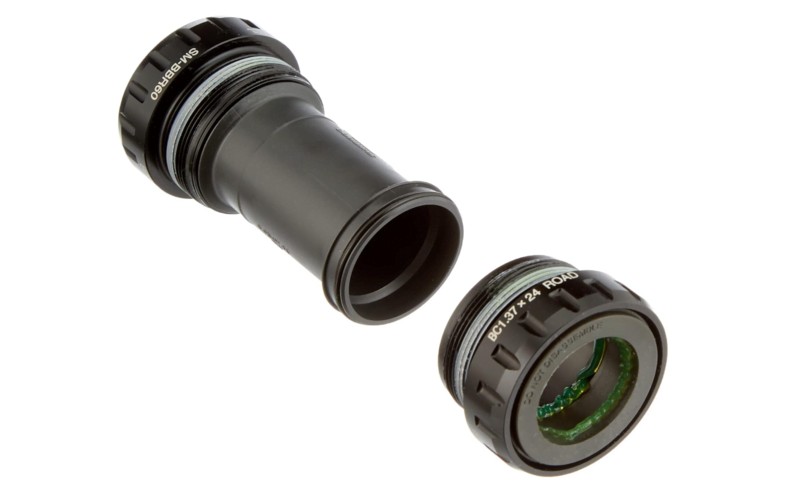
The component that holds the bearings for the crankset and fits into the frame of a road bike is called the bottom bracket. Bottom brackets are available in various shapes and sizes, but for road bike groupsets, they can be classified as either press-fit or threaded.
Threaded bottom brackets screw into the frame on threads, while press-fit bottom brackets are inserted into the frame and held in place by friction. In terms of maintenance and compatibility, threaded bottom brackets are generally considered more convenient than press-fit ones.
However, some manufacturers prefer press-fit bottom brackets for their purported advantages in weight, stiffness, and ease of production.
2. Brakes
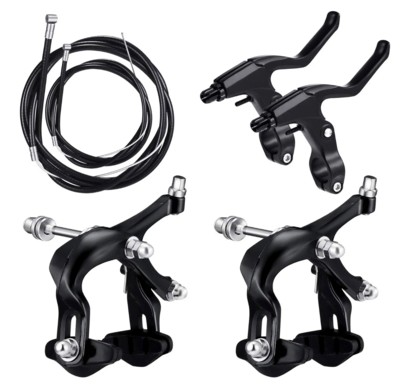
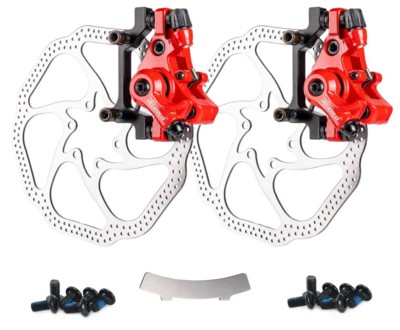
Road bikes can either have cable-operated caliper brakes that engage with the wheel rim or hydraulic or mechanical (cable-operated) disc brakes. In recent years, disc brakes have become increasingly popular, and many bikes are only available with them.
However, some types of bike bikes still offer the option of either rim or disc brakes, while others are only available with rim brakes.
Hydraulic disc brakes generally offer better performance than mechanical disc brakes because the hydraulic hoses are a closed system, which makes them less prone to performance degradation.
However, they are more expensive to purchase and maintain than mechanical disc brakes.
Some rim brake bikes now feature direct-mount rim brake calipers, which provide better performance than single-mount calipers. However, they are only compatible with specific frames.
3. Crankset/Chainset
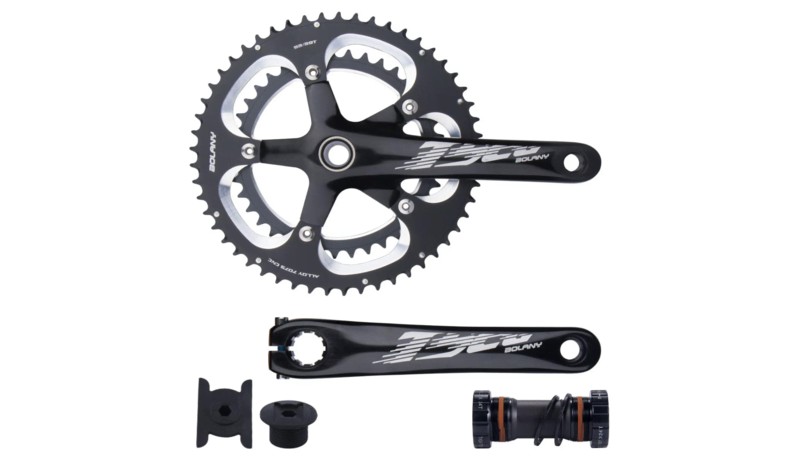
The component that houses the front gears on a road bike is called the chainset, and it can be divided into three main categories: one-by, double, and triple. A one-by system, also known as a single ring, has only one chainring, while a double has two, and a triple has three.
In addition to the chainrings, the chainset also includes the cranks that attach to the pedals. The length of the crank arms can vary from 160mm to 180mm, with the length usually related to the bike’s frame size.
For example, a 56cm frame typically has 172.5mm cranks, while smaller frames may have 170mm cranks.
Longer cranks provide a greater mechanical advantage and larger effective gear, but they can also be more difficult to turn. Shorter cranks are preferred by some cyclists in criteriums as they offer more ground clearance when pedaling around corners.
Triathletes also tend to favor shorter cranks because they enable them to maintain a higher cadence.
a. Single Chainring
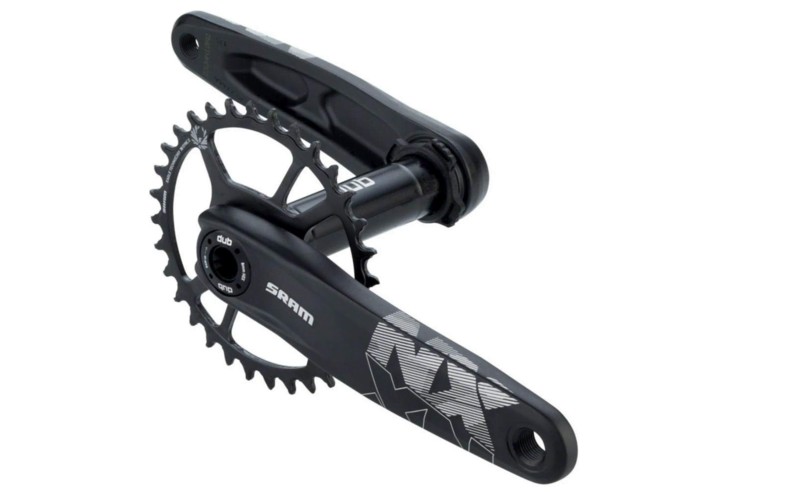
Single chainring systems compensate for having only one chainring by offering a wider range of cassettes at the rear. Common ranges include 11-42, with some SRAM electronic systems going as wide as 10-52 teeth.
Although there are larger gaps between ratios than with a double chainset, the latter may have overlapping gear ranges between the two rings, resulting in a similar number of usable gears and overall range with a 1x system.
Single-ring systems offer better chain retention as the teeth on the chainset can be made deeper and alternate between wide and narrow teeth to better mesh with the chain. 1x groupsets also feature a clutch in the rear derailleur to help keep the chain engaged.
By eliminating the front derailleur, there is less to go wrong, and there is also a weight reduction.
b. Double Chainrings
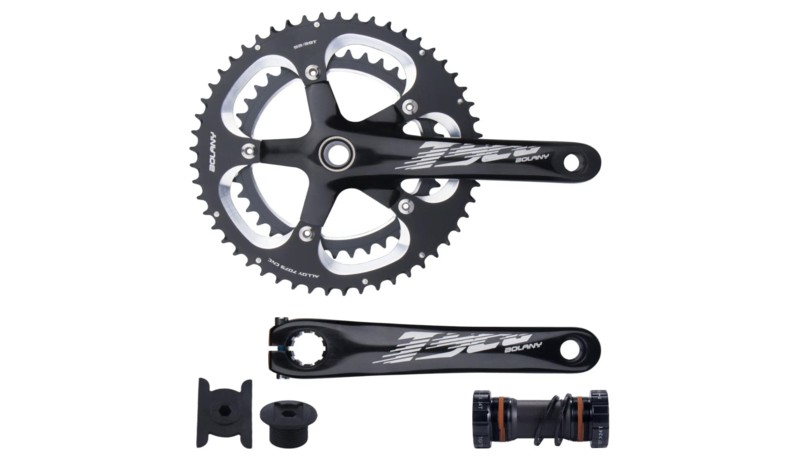
Double chainsets come in different ratios, with the standard combination of 53/39t being preferred by road racers. The numbers refer to the number of teeth on the chainring, and a larger number means a larger gear that is harder to push but can achieve higher speeds.
Compact chainsets, with a ratio of 50/34t, are currently the most commonly used gearing on road bikes. The smaller 34-tooth chainring makes this type of chainset ideal for riding in hilly terrain.
Another ratio, known as mid-compact, is also available with a 52/36 ratio. It is useful for riders who want to push a big gear down fast descents but also need a smaller inner ring to use in hilly areas.
In addition, there are also two chainring set-ups called “super-compact” or “subcompact,” which are popular on gravel bikes because of the lower ratios they provide help in off-road riding. Examples of common options include 48/32 and 46/30, but there are others available.
c. Triple Chainrings
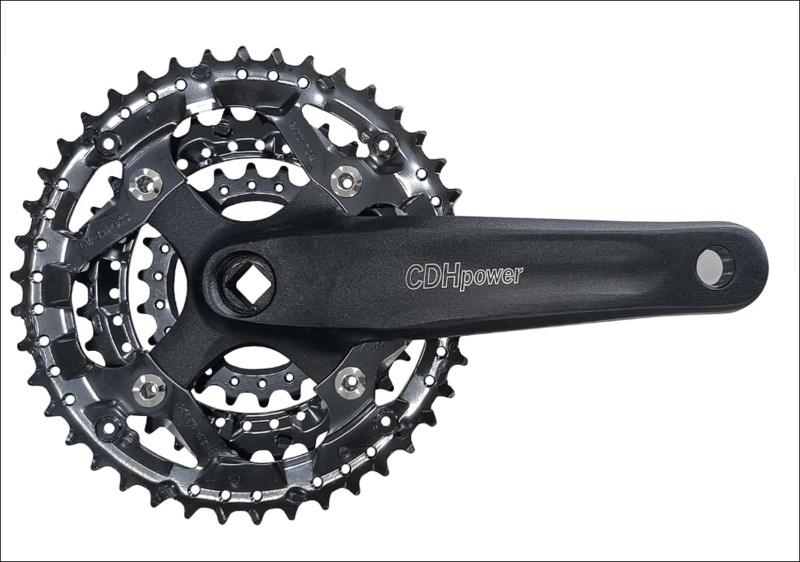
Triple chainsets are not as popular anymore and are typically found on cheaper bikes with fewer rear-shifting ratios. The front shifting is more complex than a double chainring system, and maintaining its performance can be more challenging.
Additionally, the third ring adds extra weight to the bike. However, triple chainsets are occasionally used on touring bikes because they offer a wide range of gear, which is advantageous when carrying heavy equipment.
The most common ratio for triple chainsets is 50/39/30t.
4. Cassettes
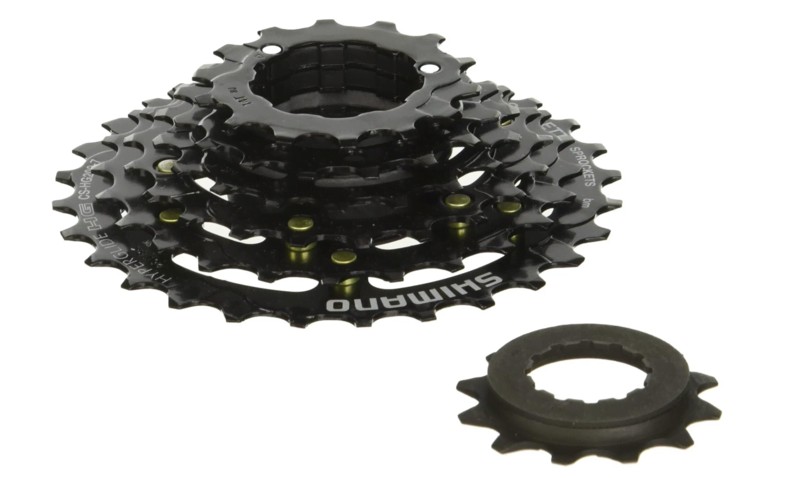
The term cassette refers to the set of sprockets on the rear wheel of a road bike. These come in a variety of ratios, with an 11-speed cassette having 11 sprockets that can be arranged with close ratios, such as 11-25t, which is ideal for time trials and racing on flatter terrain due to its fine adjustment and smooth shifting.
Alternatively, a wider ratio like 11-32t offers more gear range for hilly terrain.
Cyclists can swap out their cassettes and often own multiple ratios. However, it is important to note that the size of the largest sprocket on a cassette is limited by the length of the cage on the rear derailleur.
Therefore, it is essential to check with a local bike shop or manufacturer’s website before purchasing a 32-tooth granny gear.
It is necessary to use a cassette that matches the number of ratios in the groupset, meaning an 11-speed cassette cannot be used on a 10-speed groupset.
5. Chains
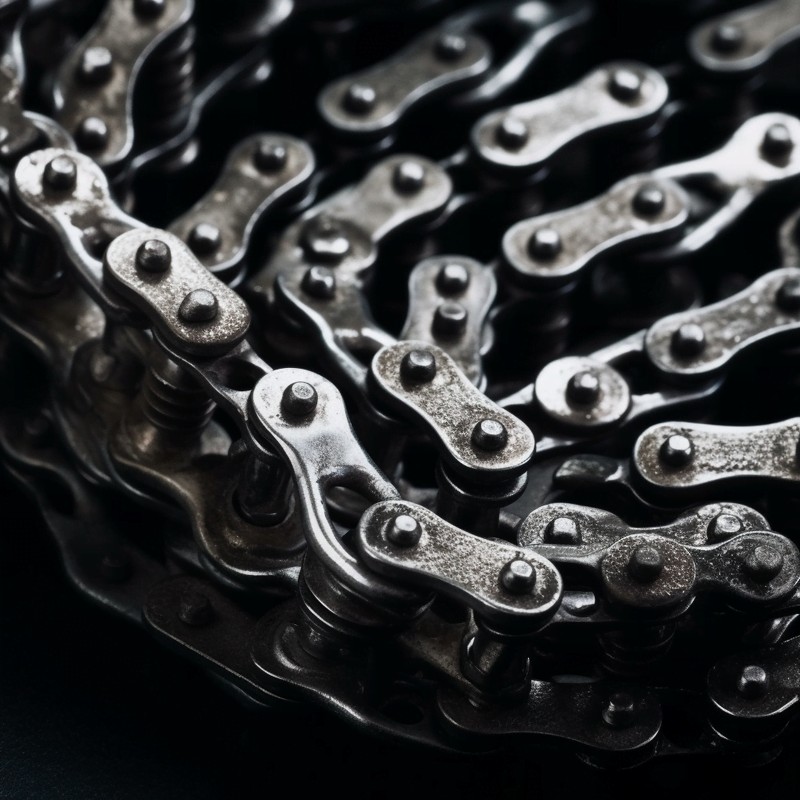
The type of chain required for a road bike is determined by the range of gears, with a 10-speed groupset requiring a 10-speed chain. Higher-end chains are often coated with alloys that provide greater resistance to wear and reduce weight.
Chains, like cassettes, wear out over time and will require replacement periodically. A chain wear indicator can be purchased inexpensively to determine when a chain needs replacing.
6. Derailleurs
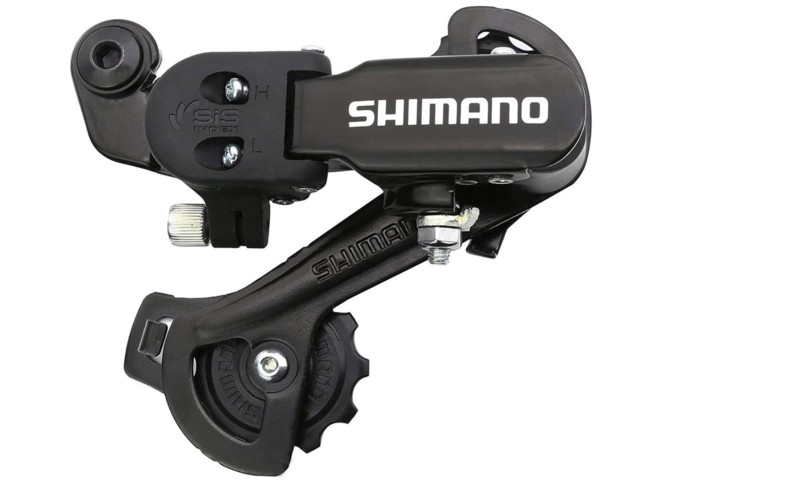
The derailleurs, also known as mechs, guide the chain from one sprocket to the next on a road bike. Cable shifting is typically used, but electronic groupsets, such as Shimano Ultegra Di2, SRAM Red eTap AXS, or Campagnolo Super Record EPS, use small motors to move the derailleur.
Rear derailleurs come with specifications that accommodate various cassette sizes, and there is often a “short cage” or “mid/long cage” option. When replacing a derailleur, ensure that it matches the cassette’s speeds and range.
Front derailleurs come in two types: band-on, which has a metal clamp that bolts around the frame, and braze-on, which attaches to the frame with bolts. When purchasing a front derailleur separately from a frame, make sure to select the correct option.
Band-on derailleurs are circular clamps that may not fit all bike frames, while braze-on derailleurs are riveted or bolted to the frame.
7. Shifters
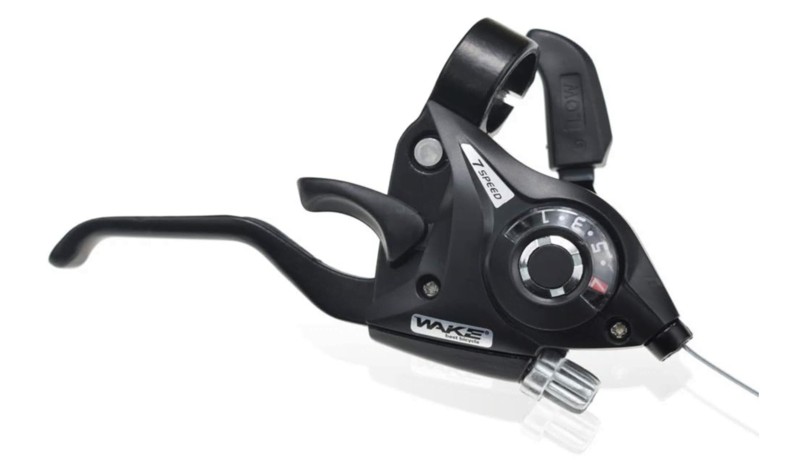
Road bike shifters are utilized for gear adjustments, with Shimano’s STI (Shimano Total Integration) shifters being the most prevalent design. To shift into an easier gear, the brake lever is pressed inward, while a secondary lever behind the first is pushed inwards to shift down.
The brake is activated by pulling the brake lever towards the rider, which also moves the second shift lever backward.
Campagnolo and SRAM shifters have similar braking methods, but their gear-shifting mechanisms differ slightly. With Campagnolo, a shifter behind the brake lever is used to shift down, while a thumb shifter inside the hoods is used to shift up.
For mechanical SRAM groupsets, shifting up requires pushing the lever in one notch, and shifting down involves pushing it slightly further.
With SRAM’s eTap electronic systems, the right shifter is pressed to shift the rear derailleur up, the left shifter is pressed to shift down at the back, and both shifters are pressed simultaneously to shift the front derailleur.
This electronic system can be programmed to alter these settings as needed.
Shimano Groupsets: Different Levels Explained
Shimano Claris R2000
- Max sprocket sizes: 28-34T
- For use with triple setups
- Compatible with 8-speed drivetrains
- Wide link design for increased rigidity and precise gear shifts
Last update on 2025-08-26 / Affiliate links / Images from Amazon Product Advertising API
Gearing: 8-speed
Shifting: Mechanical
Braking: Rim
Shimano Claris R2000 is an entry-level component range that is commonly found on the most economical road bikes.
It is an 8-speed system with eight gears at the rear, combined with either a double or triple crankset with two or three gears at the front. Stopping power is provided by rim brakes.
Shimano Sora R3000
- Shimano 3500 Rear Road Mech
- Colour Black
- 9 speed
- Road Bike use
- Medium Cage
Last update on 2025-08-26 / Affiliate links / Images from Amazon Product Advertising API
Gearing: 9-speed
Shifting: Mechanical
Braking: Rim, mechanical disc
Moving up from the Shimano Claris, the Shimano Sora R3000 is another entry-level component range that is commonly found on affordable road bikes.
It is a 9-speed system with either a standard double crankset or a wide-range triple. Similar to Claris, Sora is available with rim brakes only.
Shimano Tiagra 4700
- SHIMANO 10V CASSETTE. CS-HG500-10 11-34
Last update on 2025-08-26 / Affiliate links / Images from Amazon Product Advertising API
Gearing: 10-speed
Shifting: Mechanical
Braking: Rim, hydraulic disc
Shimano Tiagra 4700 is a 10-speed groupset that delivers comparable performance to the Shimano 105 but with some cost-saving measures, such as one-piece brake pads instead of higher-quality cartridge pads.
Since 2019, Tiagra has also introduced its hydraulic disc brakes, featuring levers that are similar to those of the 105. These replaced the non-series RS405 option, which was not as smooth. Additionally, a rim brake option is available.
Shimano 105 R7000
- Cog Sizes: 11 - 28, 11 - 30, 11 - 32t
- Cog Material: nickel plated steel
- Freehub Type: Shimano 11-speed road
- Carrier Material: aluminum
- Claimed Weight: [11-28t] 10oz (284g), [11-30t] 10.7oz (304g), [11-32t] 11.3oz (320g)
Last update on 2025-08-26 / Affiliate links / Images from Amazon Product Advertising API
Gearing: 11-speed
Shifting: Mechanical
Braking: Rim, hydraulic disc
Shimano 105 R7000 is the most budget-friendly, performance-focused groupset from the Japanese company and is found on many mid-range road bikes. This 11-speed groupset is widely regarded by riders as providing the optimal combination of performance, durability, and value.
With the launch of the most recent 105 R7000 groupset, Shimano introduced matching hydraulic levers and disc brakes. The previous ungainly RS505 levers were considered equivalent to 105.
Shimano 105 R7000 is also available with rim brakes.
Shimano 105 Di2
- Refined 12-step gear combination provides peak efficiency and accelerating performance for every situation
- Compatible with new 12-speed and road 11-speed freehub bodies
- Compatible with HG 12-speed chain
- Drivetrain Speeds: 12
- Color: Silver
Last update on 2025-08-26 / Affiliate links / Images from Amazon Product Advertising API
Gearing: 12-speed
Shifting: Electronic
Braking: Disc-brake
In June 2022, Shimano released the much-anticipated Shimano 105 Di2 R7150, which is an electronic version of the company’s third-tier groupset and competes directly with SRAM Rival eTap AXS.
Like Shimano Ultegra and Dura-Ace, which were updated in 2021, the groupset has 12-speed gearing and a semi-wireless design. This means that the derailleurs are connected to the same battery, while the shifters connect wirelessly.
The weight of Shimano 105 Di2 is approximately 2,992g, depending on the specification, and has a suggested retail price of around £1,730 / $1,890 / €1,869.
Unlike the updated Ultegra and Dura-Ace groupsets, the Shimano 105 Di2 is only available with disc brakes, and rim brakes are no longer an option.
With the release of the 105 Di2 R7150, Shimano also introduced 105 carbon fiber wheels.
Shimano Ultegra R8100
- Cog Sizes: [11-30] 11, 12, 13, 14, 15, 16, 17, 19, 21, 24, 27, 30, [11-34] 11, 12, 13, 14, 15, 17, 19, 21, 24, 27, 30, 34
- Cog Material: steel
- Freehub Type: HG
- Carrier Material: aluminum
- Claimed Weight: [11-30] 291g, [11-34] 345g
Last update on 2025-08-26 / Affiliate links / Images from Amazon Product Advertising API
Gearing: 12-speed
Shifting: Electronic
Braking: Rim, hydraulic disc
Shimano Ultegra is positioned one level below the professional-grade Dura-Ace groupset. In 2021, both groupsets underwent a complete redesign and were upgraded to 12-speed and semi-wireless shifting on the disc brake version.
This involves wireless communication between the shifters and the derailleurs, which are connected to a central battery.
The new Shimano Ultegra R8100 shares almost all of the same design features as the range-topping Dura-Ace groupset, even including a power meter option now.
As a result, it offers the performance that most riders will ever require, with the only difference from Dura-Ace being a slight weight increase in exchange for a significantly lower price.
Shimano has discontinued the mechanical shifting groupset options for Ultegra R8100 and only gave the electronic rim brake option a superficial update (it is still completely wired).
Therefore, the Di2 Disc version is the only version of the groupset that incorporates all of the latest advancements.
Shimano Dura-Ace R9200
- Faster and smoother gear shifting even at maximum pedaling loads
- Refined 12-step progressivity maximizes efficiency and accelerated performance for all situations
- Adding wider 34D specs even for pro-race use
- Compatible with the new 12v rear hub body and 11v road
- 12 Speed HG Compatible Chain
Last update on 2025-08-26 / Affiliate links / Images from Amazon Product Advertising API
Gearing: 12-speed
Shifting: Electronic
Braking: Rim, hydraulic disc
The Shimano Dura-Ace R9200 is the top-of-the-line groupset offered by Shimano and is commonly found on professional-level bikes. It features high-quality materials such as carbon fiber, titanium, and high-grade alloys and offers top-of-the-line design combined with lightweight construction.
In 2021, Shimano released the new Dura-Ace Di2 R9200 groupset, which like the Ultegra, is 12-speed and features semi-wireless shifting, which is claimed to be faster than the previous generation Dura-Ace R9170 Di2 groupset.
The disc brakes on both Ultegra and Dura-Ace have been upgraded to include Shimano’s Servo Wave lever ratio, which provides improved modulation, while the calipers offer 10% more clearance, making them quieter.
Like Ultegra, the mechanical shifting option for Dura-Ace R9200 has been discontinued, and the changes to the rim brake version are modest, leaving the Di2 Disc option as the only one to include all the latest developments.
While Dura-Ace is more expensive than Ultegra, it is also lighter and offers a larger 54-40t chainset option to better cater to the faster speeds of professional riders. Aside from this, the two groupsets function similarly.
Shimano GRX Gravel Components
Shimano introduced a range of components named GRX in May 2019, designed for gravel riding, adventure cycling, and bikepacking.
GRX is unique as it offers lower gears more suitable for these riding styles, and it includes ready-made 1x gearing options (i.e., a single chainring at the front).
GRX is not a standalone groupset but rather a collection of components that complements Shimano’s existing groupsets, with components available at Tiagra, 105, Ultegra, and Ultegra Di2 levels.
The naming convention for the GRX components is as follows: Tiagra level is RX400, 105 level is RX600, and Ultegra level is RX800 (with ST-RX810 mechanical shifters for Ultegra and ST-RX815 for Ultegra Di2).
The GRX range includes dedicated hydraulic levers, cyclocross-style inline levers, clutch-equipped Shadow RD+ rear derailleurs, front derailleurs, and 1x and 2x cranks.
SRAM Groupsets: Different Levels Explained
SRAM Apex
- SRAM 10 and 11 speed cassettes with 11 tooth cogs have the smallest cog located behind the cassette in the packaging
- Forged alloy spider holds largest cogs
- Heat treated steel cogs
- Steel lockring
Last update on 2025-08-26 / Affiliate links / Images from Amazon Product Advertising API
Gearing: 10-speed
Shifting: Mechanical
Braking: Rim, hydraulic disc
SRAM Apex is a groupset with 10 speeds and is equipped with SRAM’s WiFli system. This system provides a wide range of gears, between 11 and 32 teeth, on the rear cassette.
Some SRAM road derailleurs can even handle a 36-tooth big cog, providing the wide gear range typically found in a triple front chainset setup without the added weight and complexity of an additional chainring.
Although once unique to SRAM, similar setups are now being offered by other manufacturers.
The Apex groupset is also available in 1×11 gearing, called Apex 1, which has only one chainring at the front and 11 gears at the rear. The Apex 1 rear derailleur can handle a cassette with a large 42-tooth cog. Hydraulic disc brakes are available with Apex 1.
SRAM Rival
- SRAM 10 and 11 speed cassettes with 11 tooth cogs have the smallest cog located behind the cassette in the packaging
- Compatible with all SRAM 11-speed chains
- Optimized gear steps across entire range
- Range: 11-26
- Drivetrain Speeds: 11
Last update on 2025-08-26 / Affiliate links / Images from Amazon Product Advertising API
Gearing: 11-speed
Shifting: Mechanical
Braking: Rim, hydraulic disc
SRAM Rival is the next groupset up the line and is built from lighter materials than Apex. It also features SRAM’s WiFli system that allows for a wide gear range (between 11 and 32 teeth) for the rear cassette, similar to Apex.
Rival is available in both mechanical shifting and 11-speed configurations and can be found with either a double chainring at the front (2×11) or a single chainring (1×11) in the Rival 1 setup.
SRAM Rival eTap AXS
- Elevate your cycling experience with the SRAM Rival AXS XG-1250 Cassette, featuring X-Range� gearing for a smoother gear progression and an extended range that's perfect for road and gravel riding.
- Experience the ultimate in quiet and durable performance with nickel chrome plating and FULL PIN construction, ensuring that your rides are smooth and reliable.
- Designed to work seamlessly with an XDR� driver body, this cassette is the perfect addition to your high-performance cycling setup.
- With a 12-speed drivetrain and a 10-tooth start, the SRAM Rival XG-1250 Cassette delivers precise shifting and optimal gear ratios for any terrain.
- Unleash your cycling potential with the SRAM Rival XG-1250 Cassette, offering a stunning silver finish and a gear range of 10-36t for the ultimate riding experience.
Last update on 2025-08-26 / Affiliate links / Images from Amazon Product Advertising API
Gearing: 12-speed
Shifting: Electronic
Braking: Hydraulic disc
SRAM introduced Rival eTap AXS in 2021, adding an electronic wireless 12-speed groupset to its range. It employs similar technology to SRAM’s more expensive offerings and allows for configuration through a smartphone app, as well as featuring a power meter.
It is the most affordable electronic option from SRAM and is priced significantly lower than Shimano Ultegra Di2. It remains to be seen whether Shimano will release an electronic version of Shimano 105 in response.
SRAM Force
- SRAM 10 and 11 speed cassettes with 11 tooth cogs have the smallest cog located behind the cassette in the packaging
- Aluminum alloy lockring
- Cassette Cogs: 11-12-13-14-15-16-17-19-21-23-25
- Range: 11-25
- Drivetrain Speeds: 11
Last update on 2025-08-26 / Affiliate links / Images from Amazon Product Advertising API
Gearing: 11-speed
Shifting: Mechanical
Braking: Rim, hydraulic disc
To move up one level in terms of specifications, there is SRAM Force. This groupset is made from lightweight materials such as high-grade alloys and carbon fiber to provide a lightweight mechanical setup.
Similar to Rival, it is an 11-speed groupset that can be set up with two chainrings at the front to have a wider range of gearing or one chainring (known as SRAM Force 1) at the front to simplify the setup.
SRAM Force eTap AXS
- Experience smooth and efficient gear progression with the SRAM Force AXS XG-1270 Cassette, featuring X-Range gearing technology and at least five one-tooth jumps for a seamless shifting experience.
- Enjoy a wider gearing range with the 10-tooth small cog, designed to provide optimal performance and versatility for your rides.
- The mini cluster construction of the cassette reduces weight while increasing durability, ensuring a reliable and long-lasting component for your bike.
- Designed to work seamlessly with XDR driver bodies, the SRAM Force AXS XG-1270 Cassette offers compatibility and reliability for your electronic shifting system.
- Elevate your cycling experience with the SRAM Force AXS XG-1270 Cassette, featuring a sleek silver color and 12-speed drivetrain compatibility for a high-performance upgrade to your bike.
Last update on 2025-08-26 / Affiliate links / Images from Amazon Product Advertising API
Gearing: 12-speed
Shifting: Electronic
Braking: Hydraulic disc
SRAM Force eTap AXS was introduced in 2019 as a 12-speed wireless groupset, designed to directly rival Shimano Ultegra Di2, and with several power meter options available.
Originally launched as a pure road groupset, it received a lower and wider-range gearing option in 2020 to cater to gravel and adventure riders.
In 2023, it received an update, dropping the eTap from its name, redesigning its shifters to make them more compact, modifying its chainsets, and updating the overall look of the groupset.
SRAM offers a broad range of components covering both road and gravel use, with the latter competing with Shimano’s GRX range. However, SRAM has recently introduced its own XPLR gravel gearing system.
SRAM Red
- Hollow steel Dome makes for the stiffest gear cluster ever at the lightest weight
- Heat-treated, high-grade tool steel provides superlative durability and a beautiful finish
- Stealth ring elastomers and advanced tooth profiles eliminate vibration and noise for a smooth, silent ride
- Aluminum Cog: lighter, stiffer, stronger due to the design, material and production process
- Speeds:11
Last update on 2025-08-26 / Affiliate links / Images from Amazon Product Advertising API
Gearing: 11-speed
Shifting: Mechanical
Braking: Rim, hydraulic disc
SRAM Red is a high-end 11-speed groupset that was initially developed to compete with Campagnolo Super Record and Shimano Dura-Ace. Its components are crafted from super-light materials, including titanium, carbon fiber, high-grade alloys, and ceramic bearings.
WiFli option is also available, enabling an extremely wide range of gears. SRAM Red is one of the lightest top-of-the-range groups, weighing a claimed 1,747g. However, it’s difficult to make accurate weight comparisons between groupsets due to the lack of standardization.
SRAM has recently focused on its wireless eTap AXS groupsets, leaving mechanical Red somewhat outdated, and it’s less likely to be found on new bikes.
SRAM Red eTap AXS
Gearing: 12-speed
Shifting: Electronic
Braking: Rim, hydraulic disc
SRAM Red eTap was first launched in 2015 as a wireless electronic version of the SRAM Red 11-speed groupset. Later on, it was replaced by the 12-speed Red eTap AXS. The Red eTap AXS is offered in both disc (HRD) and rim brake configurations.
Similar to Force eTap AXS, the Red eTap AXS groupset now offers wider gear range options that can accommodate cassettes up to 10-36t, in addition to the Red XPLR drivetrain designed for gravel riding.
A Red power meter is also available as part of the groupset.
SRAM XPLR Gravel Components
SRAM introduced its XPLR components in August 2021, which cater to gravel riding and bridge the gap between road-specific and mountain bike groupsets.
The SRAM XPLR range covers Rival, Force, and the top-tier Red groupsets, all of which offer wireless electronic shifting. XPLR features 12-speed gearing in a dedicated 1× setup, with cassettes that offer a range of 10-44 teeth.
Each level comes with a new eTap AXS rear derailleur design to accommodate this gearing.
XPLR includes components from SRAM-owned brands RockShox and Zipp, such as the new gravel-specific RockShox Rudy suspension fork, a dropper post with a small amount of suspension, and gravel wheels, making it a comprehensive package.
Campagnolo Groupsets: Different Levels Explained
Campagnolo Centaur
- This cassette gives you plentiful low-end for conserving precious energy during road rides across hilly environments and gravel grinds down roads
- This cassette employs tried-and-true steel along all of its cogs for a maximum wear life
- This cassette gives a better gear for climbing
- Country Of Origin : Italy
Last update on 2025-08-26 / Affiliate links / Images from Amazon Product Advertising API
Gearing: 11-speed
Shifting: Mechanical
Braking: Rim
Campagnolo groupsets are positioned higher up in the hierarchy compared to their competitors, so it’s uncommon to find bikes under £1,000 / $1,200 / AU$1,900 equipped with Campagnolo components.
The Campagnolo Centaur groupset serves as an entry-level option, which falls under the same category as Shimano 105 and SRAM Rival. The Centaur groupset is mechanical, 11-speed, and currently only offered with rim brakes.
Campagnolo Chorus
- Chorus 12 Speed cassettes are compatible for use with both the disc and rim brake groupset
- Used the Same width freehub body as the 11-speed cassette, no need to change or update wheels
- Smaller spaces: Faster, more precise shifting
- Sets of three in single-block steel: Stiffness and elimination of power dispersion
- Same spacers: Easy error-free fitting
Last update on 2025-08-26 / Affiliate links / Images from Amazon Product Advertising API
Gearing: 12-speed
Shifting: Mechanical
Braking: Rim, hydraulic disc
The 12-speed Campagnolo Chorus is positioned just below the Record groupset range. It features a construction that utilizes lightweight alloys, carbon fiber, and titanium.
The chorus is considered to sit between Shimano Ultegra and Dura-Ace, or SRAM Force and SRAM Red in terms of performance. The groupset is available with hydraulic disc brakes and is capable of handling cassettes with up to 11-34 teeth.
Campagnolo Record
- 11-speed road race cassette
- Ultra-Shift design
- Stiff aluminum carriers
Last update on 2025-08-26 / Affiliate links / Images from Amazon Product Advertising API
Gearing: 12-speed
Shifting: Mechanical
Braking: Rim, hydraulic disc
Campagnolo Record is a top-of-the-range mechanical groupset offered by the Italian brand, featuring 12-speed shifting and available in both rim and hydraulic disc brake options.
Campagnolo Super Record
- The same width as the 11 Speed sprocket cassette
- Total compatibility with wheels and frames
- The two large triplets in a single piece eliminates energy losses
- Surface treatment increases durability and improves smoothness
- Matching-thickness spacers facilitates installation by eliminating the possibility of error.Two selections available.Reduced spaces for faster and more precise shifting
Last update on 2025-08-26 / Affiliate links / Images from Amazon Product Advertising API
Gearing: 12-speed
Shifting: Mechanical
Braking: Rim, hydraulic disc
To complement its premium mechanical groupset, Campagnolo offers an even higher-tier option called Super Record.
Like Record, it has 12-speed shifting and rim and hydraulic disc braking options, but Super Record takes it up a notch by using even more advanced materials to make each component lighter and more high-performance.
Campagnolo Super Record EPS
- Fits perfectly with all wheels and frames
- Minimizes energy waste
- Enhances longevity and smoothness
Last update on 2025-08-26 / Affiliate links / Images from Amazon Product Advertising API
Gearing: 12-speed
Shifting: Electronic
Braking: Rim, hydraulic disc
The electronic groupsets of Chorus, Record, and Super Record EPS were once available, but now only the 12-speed Super Record EPS (and its disc version) remains as the current EPS offering by Campagnolo.
It’s considered the ultimate choice by Campagnolo and is typically featured on high-end professional road bikes.
Campagnolo Gravel Groupsets Ekar
- Designed specifically for Ekar 1x13 groupsets
- Compatible with the Campagnolo N3W freehub body
- 2-piece block: blends the strength of steel and the light weight of alloy
- Compact: narrow design with quick changes, lightweight and improved chain security
- Gravel Race: 9-42T (9-10-11-12-13-14-16-18-21-25-30-36-42)
Last update on 2025-08-26 / Affiliate links / Images from Amazon Product Advertising API
Campagnolo’s Ekar is a 13-speed groupset with mechanical shifting designed specifically for gravel and adventure riding.
It’s a 1x-specific system that features cassettes starting with a 9-tooth cog, providing a range comparable to that of 2x drivetrains “without compromise,” as stated by Campagnolo.
Additionally, Campagnolo claims that Ekar is the lightest groupset made specifically for gravel, weighing a reported 2,385g for the entire package.
Other Road Bicycle Groupset Options in the Market
While Shimano, Campagnolo, and SRAM are the most well-known groupset brands for road bikes, there are a few additional options available too. They are as follows:
Rotor Road Bike Groupset
Rotor, a Spanish manufacturer known for producing cranksets and power meters, has expanded its product line to include a 1×13-speed groupset for road bikes.
Unlike traditional cable or wire systems, Rotor’s hydraulic fluid technology moves the derailleurs and brake calipers. This groupset is specifically designed for gravel bikes.
FSA Road Bike Groupset
FSA, an Italian company that’s primarily recognized for its cranksets and finishing kits such as handlebars and seat posts, also offers a rare groupset called FSA K-Force WE.
“WE” refers to “Wireless Electronic,” and this 11-speed groupset utilizes a wireless connection between the shifters and derailleurs powered by a battery located in the frame. This configuration is comparable to the latest 12-speed Shimano Dura-Ace and Ultegra systems.
Microshift
Microshift components are occasionally found on entry-level bikes as a less expensive alternative to Shimano. These components are often compatible with Shimano’s groupsets, so it’s common to see a single Microshift part paired with Shimano components.
However, Microshift also produces complete groupsets.
What Features Expensive Road Bicycle Groupset Provides
Is it always true that higher cost equates to improved performance? Perhaps, but as you move up the range, the incremental gains in performance become less significant and more difficult to detect while the equipment becomes increasingly expensive.
In terms of functionality, second-tier groupsets like Shimano Ultegra, Campagnolo Chorus, and SRAM Force are typically just as good as the pro-level components but at a considerably lower cost.
These groupsets may weigh slightly more and feature fewer flashy, high-end components.
Keeping this in consideration, let’s explore the features provided by high-end and expensive road bicycle groupsets.
1. Light-Weight
There’s a famous saying in the cycling world: “Strong. Light. Cheap. Pick two.” A lighter bike will always perform better in terms of acceleration and climbing ability than a heavier one, but achieving a lightweight construction without sacrificing strength requires a compromise.
Whether you’re considering groupsets, wheels, or complete bikes, reduced weight often drives up the cost. As you move up the range of road groupsets, they become increasingly lighter, but the amount of weight saved per dollar spent diminishes considerably at the top end.
The weight differences in groupsets are typically the result of using more expensive materials and refined, time-consuming manufacturing processes.
Expensive components often feature further machining, hole-drilling, high precision, and lightweight materials like carbon fiber, titanium, and ceramic bearings to achieve optimal weight and performance.
2. Durability
When investing more in a groupset, you would expect it to be more durable than a less expensive option.
While durability does improve with a higher price tag, my experience suggests that it plateaus with second-tier options and, in some ways, may even decline with the most expensive choice.
Technical components at a higher price point are crafted with greater precision, refinement, and materials that lend themselves to greater longevity.
This is evident in derailleurs and shifters, where cheaper options may develop play and slop over time, while higher-end parts often remain in like-new condition.
However, wearing items such as cassettes and chainrings often follows the opposite trend. Cheaper options tend to be constructed from heavier but more durable steels, while pricier versions may use lighter but softer aluminium or titanium alloys.
3. Performance
Apart from weight reduction, higher-priced groupsets offer other ways of enhancing performance. Most notably, they provide smoother, more precise, and sometimes quicker gear shifts.
This includes reduced lever effort, which becomes noticeable after several hours of riding. Electronic gears set the standard in this area, providing ultimate precision with the push of a button.
Another example of enhanced performance is increased crankset stiffness, resulting in crisper shifting and more efficient power transfer from the pedals to the rear wheel. This is achieved through more intricate designs and materials that increase strength and stiffness without adding weight.
As the price goes up, braking also offers a whole new list of benefits. More expensive brakes are stronger, provide better feel and control, and require less hand force to stop the bike.
However, this difference is more pronounced with rim brakes. There’s hardly any significant performance difference between low- and high-end hydraulic disc brakes.
Electronic vs Mechanical Shifting
For ultimate performance, electronic groupsets are the preferred option, as evidenced by their use among professional riders. They offer slightly crisper shifting and the ability to shift through multiple gears at once.
Don’t let concerns about battery recharging (which is infrequent) or vulnerability to the elements deter you; in fact, gear cables may be more susceptible to wet and muddy roads than electronic wires.
Brands typically reserve their best technology for electronic groupsets. For instance, if you want a 12-speed Shimano or SRAM system, you’ll need to choose electronic.
However, mechanical groupsets still offer many advantages. Most mechanical groupsets have excellent shifting, and if something goes seriously wrong, it’s much easier to repair than electronic ones.
Most importantly, mechanical groupsets are much less expensive. In addition, individual components are much more affordable to replace in mechanical systems.
A Bit About Groupset Compatibility Issues
It’s important to note that not all components within a particular manufacturer’s groupset are compatible with one another, even when it appears as though they should be.
Manufacturers tend to update their product lines gradually over time, so it’s not always safe to assume that two 11-speed components from the same brand will function together if they’re not from the same year or groupset.
There are also variations in the exact amount of cable pulled by different rim brake levers, meaning that you may not achieve optimal performance if you upgrade individual parts while moving up the hierarchy.
Having said that, groupsets from a particular brand are typically designed to work together as long as they have the same number of gears. (For instance, Shimano 11-speed with Shimano 11-speed and Campagnolo 11-speed with Campagnolo 11-speed.)
If you have any specific compatibility concerns, I recommend asking your local retailer before purchasing or reviewing manufacturer technical documents online.
Final Words — Road Bike Groupset
Whether you’re just starting or looking to upgrade your road bike, a quality groupset can make all the difference in your cycling experience.
Do your research, consider your options, and get ready to hit the road with a powerful and reliable road bike groupset. Please share your thoughts and feedback on the article in the comments section. Please like, share, and follow our Facebook Page for more guides like this. Have fun riding!
Road Bike Groupset — Frequently Asked Questions
Is electronic shifting worth it?
Regardless of the system, electronic shifting has several advantages. It never falls out of alignment, shifts flawlessly and more quickly than mechanical systems, and performs better when shifting under load.
However, electronic shifting is costly and requires batteries, so if you’re on a tight budget or frequently forgetful, traditional cables may be the better option.
Cable-actuated shifting has worked flawlessly for a long time and is still as reliable as ever. While electronic shifting dominates the higher tiers of cycling, you can still acquire the highest level of Campagnolo with cables.
Furthermore, the technology from high-end cabled groupsets from a few years ago has already been incorporated into today’s mid-range and budget groupsets, allowing you to get decent shifting without having to spend a fortune.
Are disc brakes worth it?
Similar to electronic shifting, the upper echelons of componentry are increasingly inclined toward disc brakes. While no manufacturer has completely abandoned rim brakes, very little research and development is being invested in enhancing rim braking for top-tier groupsets.
This trend is becoming more apparent even in the mid-range, so I recommend opting for disc brakes to future-proof your selections. However, rim brakes continue to function despite the introduction of discs.
Therefore, for those with limited budgets, vintage preferences, or weight concerns, rim brakes still have some advantages. However, don’t expect the same level of performance, particularly in wet conditions.
Can I put any groupset on my bike?
Unfortunately, NO.
Not everything is compatible, and older frames may not be able to accommodate new components. Furthermore, to utilize disc brakes, you must have a disc-compatible frame, and it must be the appropriate type of disc mount (post or flat, although converters are available).
The cranksets you can use will also be influenced by your bottom bracket.
Don’t be fooled into thinking that you can mix and match between manufacturers. Although some limited combinations are feasible, it’s best to stick to a single system, especially when electronic components are involved.
How do I choose the right gear?
Unless you’re an elite cyclist like Filipe Ganna, you probably won’t require a 60t front chainring. For most people, a compact (50/34) or semi-compact (52-36) crankset is likely the best starting point, depending on the terrain and your level of fitness.
If you’re competing, a 52/39 might be more appropriate, but it’s only available at the higher end of the range as an option.
In fact, as derailleurs become more advanced and gear ranges increase, the front chainset becomes less of a concern. A 10-34t cassette, for example, provides more versatility than an 11-25 ever could.
Related:



















